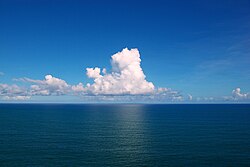
| International ownership treaties |
|---|
| Extraterritorialities |
|---|
| Earth |
| Space |
The terms international waters or transboundary waters apply where any of the following types of bodies of water (or their drainage basins) transcend international boundaries: oceans, large marine ecosystems, enclosed or semi-enclosed regional seas and estuaries, rivers, lakes, groundwater systems (aquifers), and wetlands. [1]
Contents
- Underground Transboundary Waters
- International waterways
- Disputes over international waters
- International waters agreements
- Global agreements
- Regional agreements
- Water-body-specific agreements
- International waters institutions
- Freshwater institutions
- Marine institutions
- See also
- Explanatory notes
- References
- External links
"International waters" is not a defined term in international law. It is an informal term, which sometimes refers to waters beyond the "territorial sea" of any country. [2] In other words, "international waters" is sometimes used as an informal synonym for the more formal term "high seas", which under the doctrine of mare liberum (Latin for "freedom of the seas"), do not belong to any state's jurisdiction. As such, states have the right to fishing, navigation, overflight, laying cables and pipelines, as well as scientific research.
The Convention on the High Seas, signed in 1958, which has 63 signatories, defined "high seas" to mean "all parts of the sea that are not included in the territorial sea or in the internal waters of a State" and where "no State may validly purport to subject any part of them to its sovereignty." [3] The Convention on the High Seas was used as a foundation for the United Nations Convention on the Law of the Sea (UNCLOS), signed in 1982, which recognized exclusive economic zones extending 200 nautical miles (230 mi; 370 km) from the baseline, where coastal states have sovereign rights to the water column and sea floor as well as the natural resources found there. [4]
The high seas make up 50% of the surface area of the planet and cover over two-thirds of the ocean. [5]
Ships sailing the high seas are generally under the jurisdiction of the flag state (if there is one); [6] however, when a ship is involved in certain criminal acts, such as piracy, [7] any nation can exercise jurisdiction under the doctrine of universal jurisdiction. International waters can be contrasted with internal waters, territorial waters and exclusive economic zones.
UNCLOS also contains, in its part XII, special provisions for the protection of the marine environment, which, in certain cases, allow port States to exercise extraterritorial jurisdiction over foreign ships on the high seas if they violate international environmental rules (adopted by the IMO), such as the MARPOL Convention. [8]



